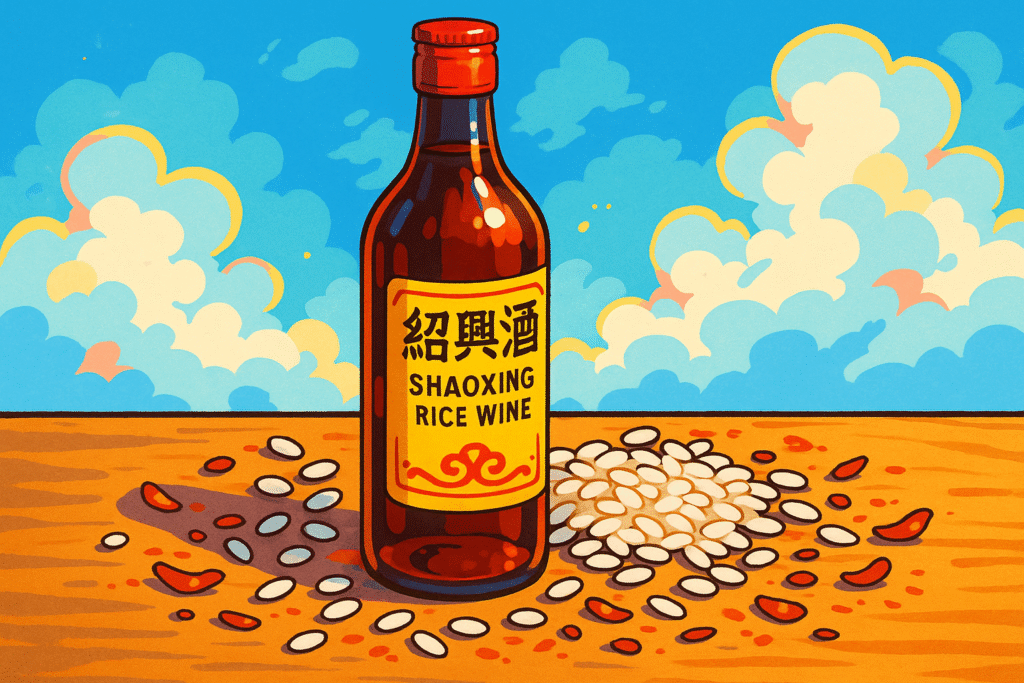Shaoxing rice wine ()

About Shaoxing rice wine
Shaoxing rice wine is an amber-colored Chinese fermented wine made from glutinous rice (Oryza sativa), wheat, and a fermentation starter known as jiuqu. With a delicate balance of nuttiness, umami, and gentle sweetness, it’s intensely aromatic and often compared to dry sherry or marsala for its cooking prowess—though its flavor is uniquely mellow, with floral and earthy notes. In Chinese kitchens, a splash of Shaoxing rice wine works wonders: it masks unwanted odors, tenderizes meat, and infuses savory stews, stir-fries, braises, and seafood with complexity. Sipped neat, it reveals even greater nuance, traditionally enjoyed warmed at festive banquets and ancestral celebrations across China.
The History of Shaoxing rice wine
Born in the waterways and paddies of Shaoxing—a city in China’s eastern Zhejiang province—this rice wine boasts over two millennia of history. Its production can be traced to at least the Spring and Autumn period (c. 770–476 BCE), with Shaoxing’s mineral-rich lake water credited for its signature smoothness. For centuries, it was the preferred drink of poets, scholars, and emperors, referenced in Chinese literature and toasts alike. In culinary tradition, Shaoxing wine has been as integral as soy sauce, called “the soul of Chinese cooking.” Iconic dishes like drunken chicken and red-cooked pork owe their character to its presence. Shaoxing rice wine’s influence even reached Japan, Korea, and Southeast Asia, where it inspired local rice wines still made today.
The Science of Shaoxing rice wine
The character of Shaoxing rice wine is shaped by natural fermentation, lasting months to years. Steamed glutinous rice, water, jiuqu (a brick of naturally cultured yeast, molds, and bacteria), and wheat undergo complex enzymatic changes: starches break down into sugars, which yeast converts into alcohol, while bacteria and molds generate aldehydes, acids, and aromatic esters. The result is a layered wine that develops flavor with aging—its signature nutty aroma comes from naturally formed amino acids and subtle oxidative notes, while the golden color deepens over time. The wine is moderately strong (usually 14–20% ABV), provides small amounts of amino acids and minerals, and its small alcohol content evaporates quickly in cooking, leaving behind only flavor.
The Geography of Shaoxing rice wine
Authentic Shaoxing rice wine must hail from Shaoxing in Zhejiang province, celebrated for its clean, mineral-rich water and humid subtropical climate. Artisanal producers favor clay urns and time-tested courtyard fermentation, while large-scale makers serve both local and global markets. The water, air quality, and local jiuqu varieties give Shaoxing wine its distinctive flavor—imitations from other regions rarely measure up. Still, numerous “Hua Diao” (花雕), “Nu’er Hong” (女儿红), or “Jiu Niang” (酒娘) styles exist, crafted in neighboring Jiangsu, Fujian, and even Taiwan, each with subtle differences reflecting local ingredients, climate, and traditions.
Varieties of Shaoxing rice wine
Hua Diao (花雕)
Named for the decorative carved flower urns it ages in. Medium-dry, deep amber color, robust aroma, and slightly oxydative complexity. Widely used for both cooking and drinking.
Nu’er Hong (女儿红)
“Daughter’s Red” is traditionally buried at a daughter’s birth and opened at her wedding. Sweeter, aged longer, with a fragrant, almost plum-like flavor.
Jia Fan (加饭)
Means “added rice.” This richer wine uses additional rice in fermentation; it’s less sweet and more mellow. Favored for pairing with delicately flavored dishes or as a sipping wine.
Xiang Xue (香雪)
“Fragrant Snow.” A lighter, paler style with a delicate bouquet and softer taste, usually reserved for ceremonial or celebratory drinking.
FAQs All your questions about Shaoxing rice wine: answered
What makes Shaoxing rice wine different from other Chinese cooking wines?
Authenticity: it must come from Shaoxing, using local water, rice, and traditional fermentation. Its taste is nuanced—nutty, layered, and gently sweet—making it more complex than mass-produced “cooking wine,” which is often salted or lacks proper aging.
Can I use Shaoxing wine as a drinking wine?
Absolutely. High-grade Shaoxing wine, especially aged types like Hua Diao or Nu’er Hong, is traditionally sipped warm. Only lower-grade or “cooking wine” versions (often salted) are not suitable for drinking due to added salt and reduced quality.
Is there a good substitute for Shaoxing rice wine in recipes?
Dry sherry is the closest in flavor for savory dishes, but true connoisseurs note that the floral notes and balance are unique. Avoid using Japanese sake or mirin, which are either too sweet or subtly different.
Does cooking with Shaoxing rice wine remove alcohol?
Most of the alcohol evaporates during cooking, especially when exposed to heat. What remains is the deep aroma and complexity it imparts to the dish.
How should Shaoxing rice wine be stored?
Unopened bottles keep well in a cool, dark place. Once opened, store in the refrigerator or a cool cupboard and use within a year for the best flavor—high alcohol and salt act as natural preservatives.